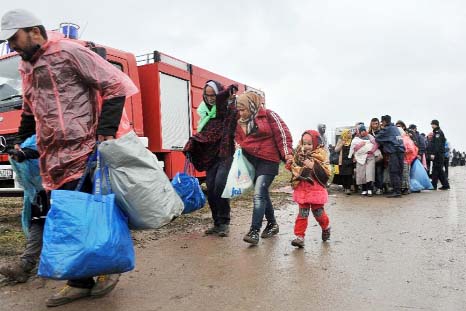
AFP, Croatia :The Croatian sun has given way to rain and the temperature has dropped, but refugees and migrants continue to stream into the country, forcing officials and charities to scramble to prepare for wintry conditions.More than 90,000 migrants, many of them fleeing conflict in the Middle East, have transited through Croatia since mid-September after EU member Hungary closed its border with Serbia, forcing them to find a new route.”It’s starting to get really cold. For someone of my origin, it’s not easy!” said Syrian student Ahmad, 22, dressed in a hooded jacket and waterproof cape.He laughs it off, but next to him others shiver on the muddy road in Bapska, an eastern village in Croatia that is the first point of entry for travellers seeking better lives in northern Europe, especially Germany.Despite the cold, the wind and the drizzle, few complain as they wait to be transferred to a reception centre in Opatovac, about 12 kilometres away.”For the adults, it’s still ok, but for the children it is starting to get difficult,” said a 58-year-old man who fled the Syrian city of Raqqa, which Islamic State jihadists have designated their capital.In these eastern Croatian plains, the weather has changed quickly.”A few days ago the people were suffering from the heat. Now the cold and rain have arrived and at night, the temperature can fall to 5 degrees,” said Nathalie Salles, coordinator of the Doctors Without Borders mission in Croatia, based in the Opatovac camp.”The risks now, especially for children, are hypothermia and respiratory infections.” The Croatian Red Cross has been distributing blankets and raincoats at Opatovac, where many have arrived without sufficient clothing, according to volunteers.At the camp, which is Croatia’s main reception centre and seen as the showcase for its treatment of migrants, the initial chaos seen in September has subsided and improvements are under way, little by little.The centre can facilitate 4,000 people, and some prefabricated housing has been erected to house children and mothers, along with new tents, some of them with heating. But the majority of migrants are housed in large military tents, on top of which rainwater regularly accumulates.Currently most of the migrants are fairly quickly ferried up to Hungary and onwards to northern Europe, but uncertainty remains about Budapest’s threatened closure of the Croatian border.The move would block thousands of migrants on parts of Croatian soil where winter conditions can be harsh.In addition to the Opatovac camp, Croatia can host 1,500 to 2,000 migrants in Zagreb and smaller numbers at other temporary shelters around the country — but they could quickly be overwhelmed by the thousands who arrive daily from Serbia.Meanwhile, Hungary’s populist prime minister called today on the US, Australia, Israel and “rich Arab nations” to take in some of the migrants flowing into Europe, while likening the influx to an “army”.”It’s not fair, that the USA doesn’t take any in, or only 10,000-15,000 refugees,” Viktor Orban told radio station Kossuth.”It’s not fair that Israel doesn’t take any at all, that Australia doesn’t take any at all, that the rich Arab countries are dithering,” he said.”Everyone looks to Europe, because someone sent the refugees out in this direction.”

